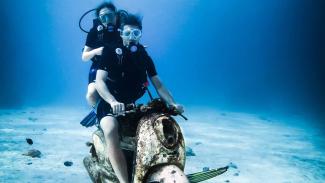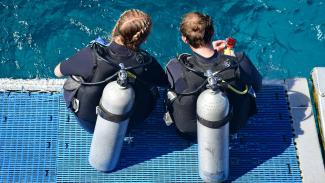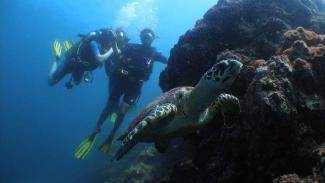Scuba Diving Terms - A Dummies Guide
Learn all the lingo to talk like a seasoned scuba diver

Frans Daniels
Scuba-diving, like many activities seems to have a language all of its own, with confusing concepts, technical terminology and an ocean of jargon to decipher.
To help newcomers break through this barrier we've developed a dummies guide to scuba diving, so that you can get to grips with what divers are talking about. Find out what SCUBA stands for, what PADI is, what it is to be narked, and so much more.
After reading our guide, you may even feel confident enough to talk the talk yourself...
Basic scuba diving terms
SCUBA
S.C.U.B.A is actually an acronym. It stands for Self Contained Underwater Breathing Apparatus. Basically speaking, it is the name for the gear you need to breathe underwater. So Scuba diving means to dive using scuba equipment.
PADI
If you’ve visited a dive center or been exposed to the diving world at all, chances are you’ve come across this term. It’s everywhere, but what is PADI? PADI is an acronym. It stands for the Professional Association of Diving Instructors. It is the world’s largest dive certification organization and many divers have taken their courses, from the Discover Scuba Diving course right up to Rescue Diver and above.
PADI is not the only dive certification organization by any means. You may also come across SSI, CMAS, NAUI, BSAC, TDI and more.
Open Water Diver
Open Water Diver is the common name for a diver who has their first certificate in scuba diving. The Open Water Certification means that a diver is competent in the water and is qualified to go on a scuba dive with a dive guide or a buddy.
Buoyancy
Buoyancy is the term used by divers to describe how they float in the water. A good diver will be neutrally buoyant, meaning they can hover motionless in mid-water. If a diver sinks to the bottom, he or she is negatively buoyant. If they rise to the surface, they are positively buoyant.
Viz
You will often hear divers talking about Viz. It means visibility, or how clear the sea is and how far you can see underwater. Normally, divers refer to viz as either 'good viz' or 'bad viz'.
Buddy
Your buddy is your faithful friend & partner for a scuba dive. Divers always dive in pairs for safety and your buddy will help make sure your equipment is in order & keep an eye on you during your dive in case you have any problems. If you are a good buddy, then you will do the same for them in return.

Laya Clode

Tara North
Technical jargon
Equalise
When you go on a dive, or underwater to any depth of note, you experience an increase in pressure. You will feel this effect in your sinuses & inner ear, which need to be equalised by breathing out through your nose while pinching it shut. You often experience the same effect when an aeroplane is coming in to land.
Bar
Bar is the measurement telling you how much air is left in your tank, as well as a place to have a drink with your friends. It refers to the amount of pressure the air is under. Generally, you will start a scuba dive with 200 bar in the tank. If your tank has 100 bar left, it means there is half as much air inside. In the US, they often use a measurement called PSI instead of bar. 3300 PSI is the same as 200 bar.
Narcosis
An effect caused when divers go a little too deep and breathe nitrogen in higher concentrations. The feeling for many is a little like being drunk, where they suffer from a lack of coordination, a misplaced feeling of security and are prone to doing slightly silly things. Many people refer to it as being 'narked'. If you ever feel narked on a dive, come a little shallower. It is not a good idea to feel drunk when you are quite a long way underwater.
Safety Stop
When you go diving, the water puts your body under pressure. Put very simply, before you surface from a scuba dive, you need to decompress your body. This means ascending very slowly and taking a 3 minute safety stop in shallow water before coming back to the surface.
You may also hear divers refer to their safety sausage, SMB, or Surface Marker Buoy. This is in an inflatable tube that allows a divers location to be clearly seen from the surface.
Deco
Deco is a common term among divers that stands for decompression limit. It usually refers to the maximum amount of time a diver can stay at a depth before he needs to come shallower. You may hear a diver say they had come shallower as they were getting close to 'deco'. This means that their dive computer was telling them they had to return to a shallower depth to stay safe.
Nitrox
Nitrox is a mix of gas that divers often use to go scuba diving instead of air. It has increased levels of oxygen, which means divers can dive for longer before they reach 'deco', or their decompression limit. Tanks containing nitrox instead of normal air are have bright green & yellow labels to tell them apart.
No Fly Time
Being underwater can feel a little like flying. The feeling of weightlessness is something truly wonderful. When divers talk about no fly time though, they are referring to an amount of time a diver must spend back on land before it is safe to take to the air in a plane. This is due to the gasses that accumulate in your body when you dive.

You might also enjoy...
Scuba Diving Terms - A Dummies Guide
Frans Daniels

